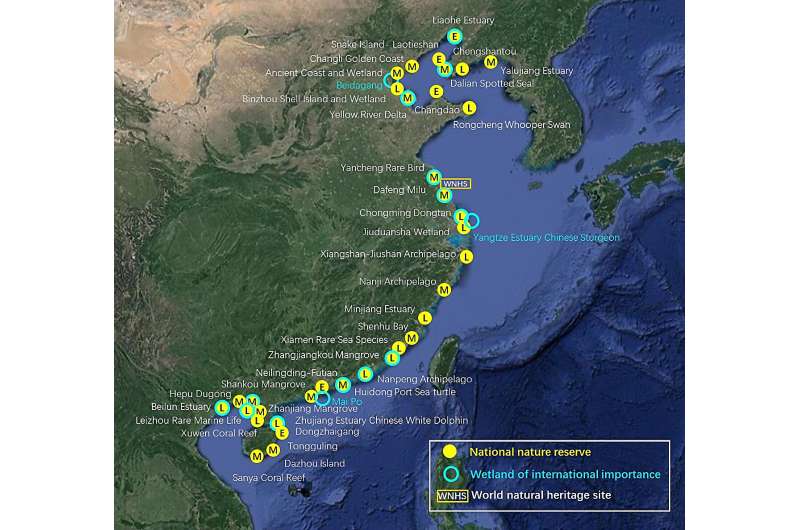This article has been reviewed according to Science X's editorial process and policies. Editors have highlighted the following attributes while ensuring the content's credibility:
fact-checked
proofread
Advancing coastal waterbird conservation in China: Policy progress and challenges

Coastal wetlands are valuable ecosystems, serving crucial roles in the carbon cycle, natural disaster mitigation, local livelihoods, and biodiversity support. Waterbirds, reliant on these wetlands, are indicative of wetland health and often considered flagship species for conservation efforts. The state of waterbirds largely mirrors coastal wetland conservation and management.
Located in the middle of the East-Asian Australasian Flyway, China's coastal wetlands serve as breeding grounds, migration stopovers, and winter habitats for tens of millions of waterbirds. Unfortunately, extensive land reclamation projects have led to the decline in waterbird populations.
While China has made significant efforts and investments in coastal wetland conservation in recent years, together with a strong commitment to future ecological conservation and restoration, the effectiveness of these conservation measures and any existing gaps remain unclear.
To that end, Zhijun Ma, an ornithologist at Fudan University, along with either other ornithologists and conservationists, recently published a review in the journal Avian Research.
The researchers highlighted the notable progress in national-level conservation legislation, regulations and action plans, accompanied by improved policy effectiveness and stakeholder engagement. Nonetheless, several pressing issues persist, primarily revolving around habitat conservation and management.
These issues include the restoration of coastal wetlands, the control of invasive Spartina alterniflora (smooth cordgrass), management of environmental pollution, and the enhancement of artificial habitat quality. The authors emphasize the critical importance of safeguarding natural tidal wetlands and elevating habitat quality, particularly for coastal waterbirds highly reliant on intertidal habitats.
Furthermore, some projects, promoted as "ecological restoration" with substantial investments in vital waterbird sites, have inadvertently converted natural tidelands into harmful artificial landscapes, threatening waterbird conservation.
"We recommend regular pollutant monitoring, along with eco-friendly economic models and restricting agrochemicals, insecticides, fungicides and antibiotics in coastal areas," said Ma. "Many waterbirds, including threatened species, frequent human-managed habitats. Mitigating human activity impact and addressing human-bird conflicts are essential aspects for coordinating conservation with local economic development."
In 2022, China's central government set an ambitious aim to eradicate invasive Spartina along the coast, targeting a 90% reduction in invaded areas by 2025. The authors highlight that there are still challenges include tailoring methods to regional conditions, mitigating large-scale project impacts on the local environment and biodiversity, and preventing future Spartina re-invasion. Swift habitat restoration post-Spartina eradication is needed to create suitable waterbird habitats.
"Nevertheless, we believe there are great opportunities for further improving the efficacy of waterbird conservation and coastal wetland protection in China. What we need for future coastal waterbird and wetland conservation is more science-based and evidence-based decision making and actions," added Ma.
More information: Zhijun Ma et al, Achievements, challenges, and recommendations for waterbird conservation in China's coastal wetlands, Avian Research (2023). DOI: 10.1016/j.avrs.2023.100123
Provided by KeAi Communications Co.




















